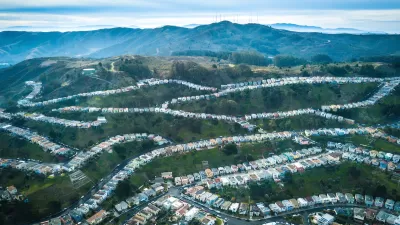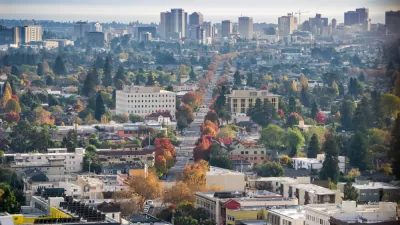As San Diego is paralyzed by the cost to maintain its infrastructure, Howard Blackson revels in a eureka moment, provided by Chuck Marohn, in recognizing the city's explicitly suburban pattern of development is a well-documented financial blunder.
Much of the projected city deficits these days are due to "upgrades" to existing infrastructure that require wider, faster roads, and other auto-centric design and programming. Blackson reviews last week's analysis of San Diego by Strong Town's Chuck Marohn, and suggests the first step to solving urban woes is to understand the root problem:
"I contend that we also need to reassess how we calculate for our current infrastructure deficits. Our deficit numbers include retrofitting older urban streets into wider, faster, more suburban thoroughfares in order to achieve the mythical Level of Service C, which in fact creates more congestion. We also calculate for conventional storm drains that move water as fast as possible from point A to Point Sea; rather than promoting a more economical and ecological Light Imprint network approach. And, our new park standards require large acreage, more expensively programmed, because it's easier to maintain with fewer city workers. These improvements are assumed to be built in a suburban pattern, which is impossible to build in existing neighborhoods where the deficits exist. According to Dr. Einstein, my city is clinically insane for using conventional suburban development patterns and regulations over and over again and expecting different urban outcomes."
Thanks to Hazel Borys
FULL STORY: Infrastructure Deficit Disorder: The Doctor is In

Depopulation Patterns Get Weird
A recent ranking of “declining” cities heavily features some of the most expensive cities in the country — including New York City and a half-dozen in the San Francisco Bay Area.

California Exodus: Population Drops Below 39 Million
Never mind the 40 million that demographers predicted the Golden State would reach by 2018. The state's population dipped below 39 million to 38.965 million last July, according to Census data released in March, the lowest since 2015.

Pennsylvania Mall Conversion Bill Passes House
If passed, the bill would promote the adaptive reuse of defunct commercial buildings.

Google Maps Introduces New Transit, EV Features
It will now be easier to find electric car charging stations and transit options.

Ohio Lawmakers Propose Incentivizing Housing Production
A proposed bill would take a carrot approach to stimulating housing production through a grant program that would reward cities that implement pro-housing policies.

Chicago Awarded $2M Reconnecting Communities Grant
Community advocates say the city’s plan may not do enough to reverse the negative impacts of a major expressway.
City of Costa Mesa
Licking County
Barrett Planning Group LLC
HUD's Office of Policy Development and Research
Mpact Transit + Community
HUD's Office of Policy Development and Research
City of Universal City TX
ULI Northwest Arkansas
Town of Zionsville
Urban Design for Planners 1: Software Tools
This six-course series explores essential urban design concepts using open source software and equips planners with the tools they need to participate fully in the urban design process.
Planning for Universal Design
Learn the tools for implementing Universal Design in planning regulations.
























